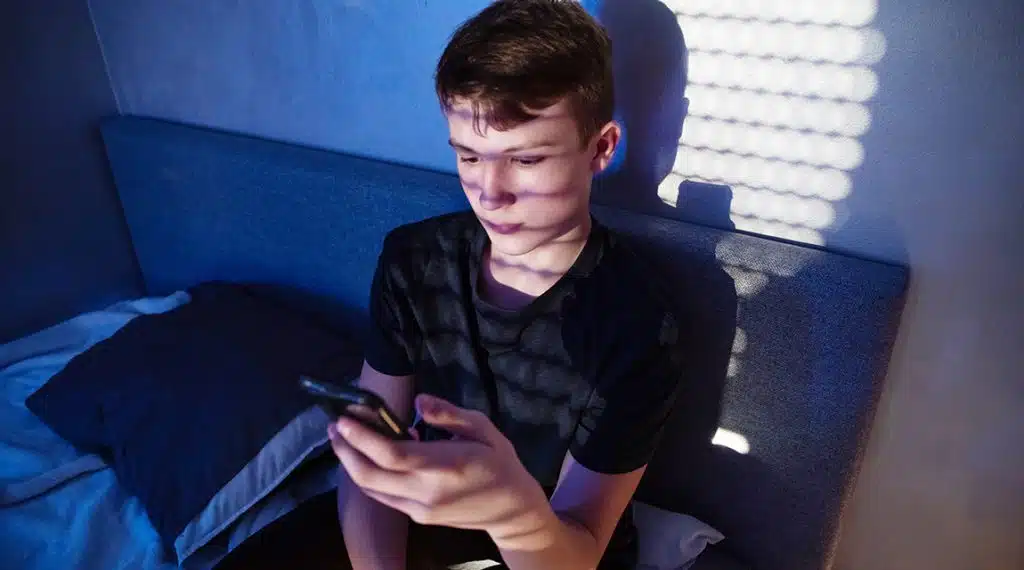Digital self-harm is a form of self-harming in which teens anonymously post mean and hurtful comments about themselves on social media platforms or other online forums. They may be seeking help and sympathy, or testing their friends to see who will stand up for them. Or they may use digital self-harm as an unhealthy way to cope with and express painful emotions. This is just one of the potential negative effects of social media on teens.
As with other types of teen self-harm, this behavior typically stems from feelings of distress and self-hatred. Digital self-harm is associated with depression, substance abuse, and low self-esteem. Moreover, recent research shows that adolescents who engage in digital self-harm are up to 15 times more likely to make a suicide attempt.
Key Takeaways
- Adolescents who digitally self-harm usually do so as a way to cope with overwhelming negative feelings.
- Digital self-harm is more common in teens with depression, anxiety, substance use disorder, eating disorders, and other mental health issues.
- Teens who engage in digital self-harm have a much higher risk of having suicidal thoughts and making a suicide attempt.
- Through parent support and mental health treatment, teens who digitally self-harm can heal the root causes of this destructive behavior.
What Is Digital Self-Harm?
In order to engage in digital self-harm, teens post anonymously on social media platforms or create separate online personas and profiles. Then they use these “ghost accounts” to post hateful remarks directed toward themselves. Other users then interact with the content through comments, responses, questions, likes, etc.
Also referred to as self-cyberbullying, cyber self-harm, and self-trolling, digital self-harm is a relative new phenomenon. It first came into public awareness after the 2013 suicide of 14-year-old Hannah Smith of Leicestershire, England.
Her death was initially blamed on the cyberbullying she had experienced on the social networking service Ask.fm. However, it turned out that she was the one who had been posting the negative comments.
In a similar case in 2016, a 15-year-old girl from Texas died by suicide after apparently engaging in digital self-harm. In her anonymous posts on the now-defunct social platform After School. she called herself “ugly” and commented that she “should kill herself.” As with many others who self-harm in this way, she had been the victim of bullying by others.
Digital self-harm has been described as “digital Munchausen” because it shares some characteristics with Munchausen Syndrome. People with Munchausen or Munchausen by proxy deliberately make themselves or their children sick as a way to get attention and sympathy.
How Common is Digital Self-Harm in Teens?
A 2017 study published in the Journal of Adolescent Health examined the online behavior of some 5,500 teens (ages 13–17) to learn more about digital self-harm in adolescents. Researchers found that about 6 percent of high school students had anonymously posted something online about themselves that was mean.
In general, teen boys were more likely than girls to self-cyberbully (7 percent versus 5 percent). Furthermore, the study found that LGBT teens were three times more likely to digitally self-harm as compared to their straight, cisgender peers.
Among the teens who had engaged in digital self-harm, about half said they had only done so once. A third reported having done so a few times, and about 15 percent admitted they had cyberbullied themselves many times. Those who had been victimized by others online were more likely to digitally self-harm.
Why Do Teens Engage in Digital Self-Harm?
Since this concept came to light, researchers have been working on defining digital self-harm and its causes. Consequently, they have identified a number of reasons why teens cyberbully themselves, including:
- Doing it as a joke or because they’re bored
- Showing they are tough and can take it (in their role as the victim)
- As a cry for help and support, including mental health counseling
- Testing their friends to see if they’ll stand up for them
- Hoping to get compliments or sympathy from peers, similar to sadfishing
- Trying to get the attention of their parents or other adults
- Gauging whether others share their negative opinions of themselves
- Warding off cyberbullying from others by doing it to themselves first
- Using it as a form of self-punishment due to self-loathing thoughts
- Attempting to feel a sense of control
- Combating feelings of emotional numbness or dissociation from oneself
- Using it as an unhealthy coping mechanism to distract from psychological pain
While digital self-harm may seem like a manipulative teen behavior, adolescents who cyberbully themselves usually do so as a result of overwhelming negative feelings. They may be unable to turn to family or friends for support, due to shame, poor relationships with parents, or fear of rejection. So they use this destructive method as a way to express their emotions and seek help. Unfortunately, digital self-harm often makes their painful feelings worse, and may not garner the support teens are looking for.

Teen Mental Health and Digital Self-Harm: Research and Risk Factors
Teens who engage in digital self-harm are more likely to have had traumatic experiences and struggled with emotional pain or mental health issues. Here are some of the associations and risk factors researchers have uncovered.
Psychological distress: Teen digital self-harm is linked with high levels of negative emotions and thoughts and lack of self-esteem. The adolescents surveyed in the 2017 research study reported digitally self-harming in response to negative feelings such as emptiness, self-hatred, abandonment, guilt, desperation, isolation, and stress.
Existing mental health and substance abuse issues: In general, teens who digitally self-harm are more likely to have depression, anxiety, or eating disorders, or to be at risk for these mental health issues. One study of university students found that those who digitally self-harmed had a higher likelihood of experiencing three or more psychiatric issues during high school. And they were also more likely to report frequently using drugs and alcohol.
Other experiences of bullying: In addition, teens who have been victims of online bullying or bullying at school are more likely to digitally self-harm.
Previous self-harming or risky behavior: Teens who have engaged in physical self-harm, such as cutting, or in other risky behaviors, are more likely to cyberbully themselves.
The Link Between Digital Self-Harm and Teen Suicide Attempts
A startling study illuminates the link between digital self-harm and teen suicidal ideation and suicide attempts. Published in the journal Child and Adolescent Mental Health, the 2022 research found that digital self-harm in teens was associated with a drastically increased suicide risk. The data showed that adolescents who had engaged in digital self-harm were five to seven times more likely to have suicidal thoughts. And even more troubling, they were between nine and 15 times more likely to make a suicide attempt.
Overall, about 8 percent of the 5,000 US middle and high school adolescents reported that they had thought seriously about attempting suicide in the past year. In addition, 5.3 percent said they had attempted suicide during that time period. LGBTQ teens were significantly more likely than straight, cisgender teens to have seriously thought about attempting suicide (24 percent vs. 7 percent). And the LGBTQ group was twice as likely to have made a suicide attempt (10 percent vs. 4.9 percent).
“It is clear that those youth who participate in digital self-harm are much more likely to think about or attempt suicide when compared to peers who do not engage in digital self-harm. When considering the marked rise in sadness and hopelessness among U.S. adolescents over the last 10 years, our findings serve as another indicator that reflects a worsening state of mental health among teens.”
Sameer Hinduja, co-author of the 2022 digital self-harm and teen suicide study
Other Teenage Self-Harming Behaviors to Watch For
Unfortunately, digital self-harm is only one of the deliberate self-harm behaviors that adolescents engage in. As rates of teen mental health issues continue to rise, self-harming behavior increases as well. Data from the CDC shows that up to 30 percent of teenage girls and 10 percent of boys say they have intentionally injured themselves. One study found that as many as 25 percent of young people engage in self-harm, primarily physical self-harm. Social media has contributed to this rise by providing a place where teens can share dangerous self-harm content.
Some of the different types of teen self-harm include:
- Cutting, scratching, biting, or burning the skin
- Hitting or punching themselves or the walls
- Piercing their skin with sharp objects
- Pulling out hair
- Picking at scabs and wounds
- Inserting objects into the body
- Overdosing on drugs or drinking to excess
- Exercising to the point of collapse or injury
- Getting into fights in which they are likely to be hurt
- Banging head or body against walls and hard objects
- Having unsafe sex
Reasons for Adolescents’ Physical Self-Harm
As with digital self-harm, teens use other forms of self-injury to release feelings of pain, tension, and anxiety. In addition, they may engage in self-harm because they want to punish themselves for what they see as their faults or flaws. Moreover, teens sometimes injure themselves because the physical pain of self-harming seems better than numbness and emptiness that come with depression.
Additionally, teens can become addicted to self-harm. The behavior may bring a temporary sense of calm, but when the feelings inevitably return, teens self-harm again in a compulsive cycle. That’s how some teens become addicted to cutting or other self-injurious behaviors. Digital self-harm can be addictive as well.
If your teen or someone you know is feeling sad, hopeless, or is at risk of self-harm, call or text the national Suicide and Crisis Lifeline at 988. Free and confidential support is available 24/7.
3 Steps for Parents to Prevent Digital Self-Harm in Teens
Do you think your teen might be engaging in anonymous or pseudonymous posting at their own expense? Here are some ways to stop and/or prevent digital self-harm.
Step 1: Take practical steps to limit time online
If your teen has a fake or anonymous account they are using to digitally self-harm, block it or take it down. In addition, limit your teen’s time on social media platforms. Because teens tend to use social media on their phones at night, consider setting up a charging area in a common living area. Then the whole family can plug in their phones at night. younger children, it may be appropriate to use a monitoring app to track their online activity and ensure they are not interacting with self-harm content.
Step 2: Keep the lines of communication open
Teens sometimes keep secrets from parents because they’re ashamed, afraid of disappointing them, or trying to avoid punishment for their behavior. Rather than judging teens for their self-harming behavior, parents and other caregivers need to offer compassion. Reassure them that they are loved and accepted no matter what. And encourage them to come to you for support rather than defaulting to a destructive coping mechanism.
Step 3: Get support from a mental health professional
While reducing teens’ social media may prevent digital self-harm for the moment, it won’t address the root causes. As we have seen, digital self-harming is linked to higher suicide risk and can make existing psychological disorders worse. Therefore, teens who engage in this behavior should always be assessed and treated by a mental health professional. A teen mental health treatment program can create a support system for adolescents that includes therapists, medical providers, and peers who are also in recovery from self-harm and mental health issues.

Treatment for Adolescent Self-Harming and Suicidal Behavior
At Newport Academy, we heal teen mental health conditions and destructive behaviors by addressing the trauma and attachment wounds that catalyze these issues. Rather than focusing on symptoms, our clinical model heals the underlying causes of teens’ distress and suffering.
During their time in treatment, clients learn healthy coping mechanisms that replace maladaptive behaviors like self-harming and substance abuse. They learn to recognize their triggers, identify their emotions, and calm themselves. Through our family-focused approach, families build trust and strengthen communication skills, so teens can go to their parents for support when they are struggling.
Contact us today to learn more about how we bring teens and families together and give adolescents the tools they need to recover and thrive.
Frequently Asked Questions
Why do teens engage in digital self-harm?
How common is digital self-harm?
How can parents help prevent digital self-harm?
What are other forms of self-harm?
How can building a support system help prevent self-harm?
Sources
Child Adolesc Mental Health. 2022 July; 28(1): 52–59
Front. Psychol. 2020 Jan. 10: 10.3389.
J Adolesc Health. 2017 Dec; 61(6): 761–766.
MARC Research Reports. 2012; Paper 5.






